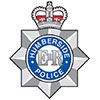More about this area

The force says...
Humberside Police covers an area of 1,356 square miles, centred on the Humber Estuary with an increasingly diverse population of 918,000. The area includes the city of Hull, the towns of Grimsby and Scunthorpe and the large rural area of the East Riding of Yorkshire. Approximately one million people a year travel to and from Europe by ferry via Hull and a further 250,000 people travel on flights from Humberside airport. The Humber port infrastructure accounts for more than 15% of the UK overseas trade. The Humber Estuary is a centre for the offshore wind industry which continues to attract significant investment.
The urban areas of the Force suffer from high levels of deprivation. Two of the four local authorities are in the bottom quartile of the most deprived areas in the country.
The force has over 3,000 staff including 1,546 police officers (with plans to recruit 300+ additional officers by March 2018), supported by police staff, PCSOs, Special Constabulary and volunteers. More than £46m worth of savings have been made since 2010.
Approximately 490,000 calls for service have been dealt with and 69,201 crimes recorded in the last year. Recorded crime levels are historically high in comparison to most other forces, despite reductions of 40% since 2005/06. The nature and complexity of crime is changing with vulnerability becoming an increasing theme. Domestic Abuse incidents have increased by 27% and child protection referrals by 25% in the last year. To address this, the force has an operating model which allows for the prioritisation and deployment of resources based on an assessment of threat, harm and risk.
Hull is the UK City of Culture 2017. The force is an official partner and will be providing support to the vast majority of the 232 planned events.
Disclaimer: the above statement has been prepared by Humberside Police. The views and information in it are not necessarily those of HMICFRS.
HMIC says...
Humberside Police provides policing services to the East Riding of Yorkshire, Kingston-upon-Hull, North Lincolnshire and North East Lincolnshire. The police force area covers 1,357 square miles with approximately 133 miles of coastline in the east of England. Although there are some more affluent areas, Humberside has a high level of poverty. Around 0.9 million people mainly live in the urban centres which include the city of Kingston upon Hull, as well as the towns of Bridlington, Scunthorpe and Grimsby. The resident population is increased by university students and the large numbers who visit or travel through the area each year. The transport infrastructure includes major sea ports.
England and Wales is made up of over 181,000 small areas known as census output areas (OAs). These have been defined by the Office for National Statistics to group together people with similar characteristics and to include, on average, 125 households. The size of the geographical area covered by each OA varies according to the population density in different parts of the country. The largest OA in England and Wales covers 20,166 hectares, and the smallest less than 0.02 hectares. A football pitch is approximately 0.75 of a hectare.
There are 1,967 OAs in Humberside with an average size of 116 hectares which is bigger than the national average of 87 hectares. While the majority (62 percent) of OAs in Humberside are relatively small at under 10 hectares, a smaller proportion (14 percent) are extremely large in size (over 100 hectares) indicating the mixture of urban and rural localities. The smallest OAs are concentrated in Hull and the numerous towns of the region with the largest spread across the more sparsely populated rural areas.
The advantage of analysis at output area level is that it supports a people-centred approach. Differences in the socio-economic characteristics of people who live in different OAs lead to different behaviours, including the use of public services. These differences are reflected in the information that is collected in large data sets such as the census, the Ordnance Survey (OS) point of interest data and other quasi-economic sources that have been used in this analysis.
HMIC has been working with the London School of Economics to use econometric techniques to statistically model and predict the level of reactive demands for police services in each OA in England and Wales. Using police incident data and several thousand characteristics (variables) drawn from the census data, OS point of interest data and other smaller data sets for each OA, it has been possible to predict the number of incidents for each OA and determine how challenging each OA is likely to be to police. We have also used the house prices from the Land Registry as a proxy indicator of wealth. Humberside has a median house price, based on the OAs that have had a property transaction within the last 12 months, of £132,417 which is lower than the median of England and Wales (£230,358). Humberside has 27.9 percent of its OAs within the lowest 10 percent of house prices nationally, while 3.0 percent of OAs are within the top 10 percent of house prices nationally (and 0.5 percent of OAs are within the top 1 percent). This suggests that there are large areas of lower value housing and deprivation, with a very small proportion of affluence and high house prices.
The demands for police services are not the same in every area of England and Wales. Our analysis has revealed that the socio-demographic characteristics of an area influence the demands for police services in that area.
In every police force, there is a concentration of predicted demands in a small number of its OAs. Taking England and Wales as a whole the most challenging 1,811 (1 percent) of these account for 10.8 percent of all the predicted incidents. We have designated these areas of very high challenge and found that they are characterised by a high concentration of people living, working, socialising or travelling in the area. Features which both cause and/or indicated a concentration of people include the number of commercial premises, including licensed premises, fast food premises, public transport and social deprivation. In some areas, these features are in combination.
Some 1.4 percent of the very high challenge areas nationally are in Humberside. The highest-challenge one percent of OAs in the force account for 11.1 percent of Humberside’s predicted incidents, these predicted demands are likely to occur in only 1.0 percent of the total area of the force.
Within Humberside:
- the proportion of OAs that are a very high challenge to police based on the predicted level of incidents is higher than the national level of one percent;
- the proportion of OAs that are a very high challenge to police based on the predicted level of crime is very high compared with the national level of one percent;
- the proportion of OAs that are a very high challenge to police based on the predicted level of anti-social behaviour is broadly in line with the national level of one percent;
- the proportion of OAs that are very high challenge to police for the predicted level of emergency and priority calls for assistance at incidents is higher than the national level of one percent; and
- the proportion of OAs that are very high challenge to police for the predicted level of emergency and priority calls for assistance at crimes is very high compared with the national level of one percent.
As an indication of the challenge for the police to reach citizens in all parts of Humberside we calculated the average travel time and distance from the central point of the force area to the centre of each of the 1,967 OAs. These calculations of distance and time are based on using the road network under normal driving conditions and speeds, and indicate the size of the area and the quality of its road network.
Humberside has 83 miles of motorways and trunk roads; the average travel distance of 18 miles (longest 42 miles and shortest 0.14 miles) and the average travel time of 31 minutes from the centre of the force to each OA are in line with the respective national averages of 17 miles and 30 minutes. This demonstrates the size of Humberside and the nature of its roads.
While the concentration of demands in a small number of locations (covering a very small area) may be helpful in focusing resources, it is not the totality of demand. The provision of services extends beyond those areas that are a very high challenge to police and includes the least challenging and most remote areas. The challenge of providing services throughout Humberside is a function of many things including the size and topography of the area, the road network and how congested the roads are. These considerations influence how police resources are organised and managed – for example, where police officers are based and their working patterns.




